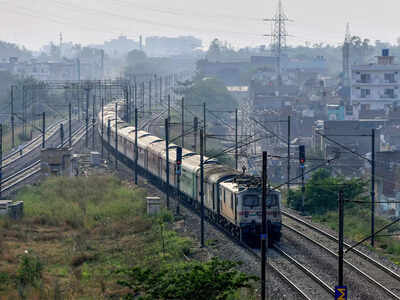Top Searches
- News
- India News
- Upgrade tracks, don’t go for elevated network on existing routes to run semi-high speed trains: World Bank to railways
Upgrade tracks, don’t go for elevated network on existing routes to run semi-high speed trains: World Bank to railways

NEW DELHI: After carrying out physical surveys of two busy rail routes, the World Bank has suggested that Indian Railways should upgrade existing tracks to run semi-high speed trains at 160 kmph-200 kmph rather than going for vertical networks on the existing routes for such. However, it has suggested
Sources said the World Bank has flagged that there are several foot and rail overbridges, overhead traction with high transmission wire en-route on Delhi-Varanasi and Nagpur-Mumbai routes which it surveyed to suggest possible models for elevated tracks based on its global experiences.
TOI, on February 7, had first reported that the railways had reached out to the World Bank to explore options for high-speed trains running on elevated tracks while the existing tracks could be used for running freight trains.
Officials said the World Bank has suggested that existing track can be upgraded to 160 kmph to 200 kmph as track structure and geometry of the railways are of high quality. They added there is a dire need to improve the tracks and system to run faster trains to meet the growing demand of passenger traffic.
The railway ministry has invited a fresh bid for procuring 100 Vande Bharat trains with maximum design speed of 200 kmph.
Sources said the World Bank has suggested the need to increase the corridors and network of the Dedicated Freight Corridors to decongest the existing corridors, which are used by both passenger and freight trains.
According to sources, another suggestion that the World Bank has made is that the bullet train projects such as Mumbai-Ahmedabad will cater to a specific class of passengers willing to pay high fares to save time. It has suggested that there should be point-to-point elevated rail corridors for running high speed and semi-high speed trains and these can be connected to the other rail networks.
In many countries elevated networks, including in Japan, Korea, several countries in Europe and Taiwan and China came in a big way. In China, the passenger network was elevated and the ground network was used for cargo, which can do very well at 60 kmph.
Sources said the World Bank has flagged that there are several foot and rail overbridges, overhead traction with high transmission wire en-route on Delhi-Varanasi and Nagpur-Mumbai routes which it surveyed to suggest possible models for elevated tracks based on its global experiences.
TOI, on February 7, had first reported that the railways had reached out to the World Bank to explore options for high-speed trains running on elevated tracks while the existing tracks could be used for running freight trains.
Officials said the World Bank has suggested that existing track can be upgraded to 160 kmph to 200 kmph as track structure and geometry of the railways are of high quality. They added there is a dire need to improve the tracks and system to run faster trains to meet the growing demand of passenger traffic.
The railway ministry has invited a fresh bid for procuring 100 Vande Bharat trains with maximum design speed of 200 kmph.
Sources said the World Bank has suggested the need to increase the corridors and network of the Dedicated Freight Corridors to decongest the existing corridors, which are used by both passenger and freight trains.
According to sources, another suggestion that the World Bank has made is that the bullet train projects such as Mumbai-Ahmedabad will cater to a specific class of passengers willing to pay high fares to save time. It has suggested that there should be point-to-point elevated rail corridors for running high speed and semi-high speed trains and these can be connected to the other rail networks.
In many countries elevated networks, including in Japan, Korea, several countries in Europe and Taiwan and China came in a big way. In China, the passenger network was elevated and the ground network was used for cargo, which can do very well at 60 kmph.
FOLLOW US ON SOCIAL MEDIA
FacebookTwitterInstagramKOO APPYOUTUBE

Start a Conversation
end of article










